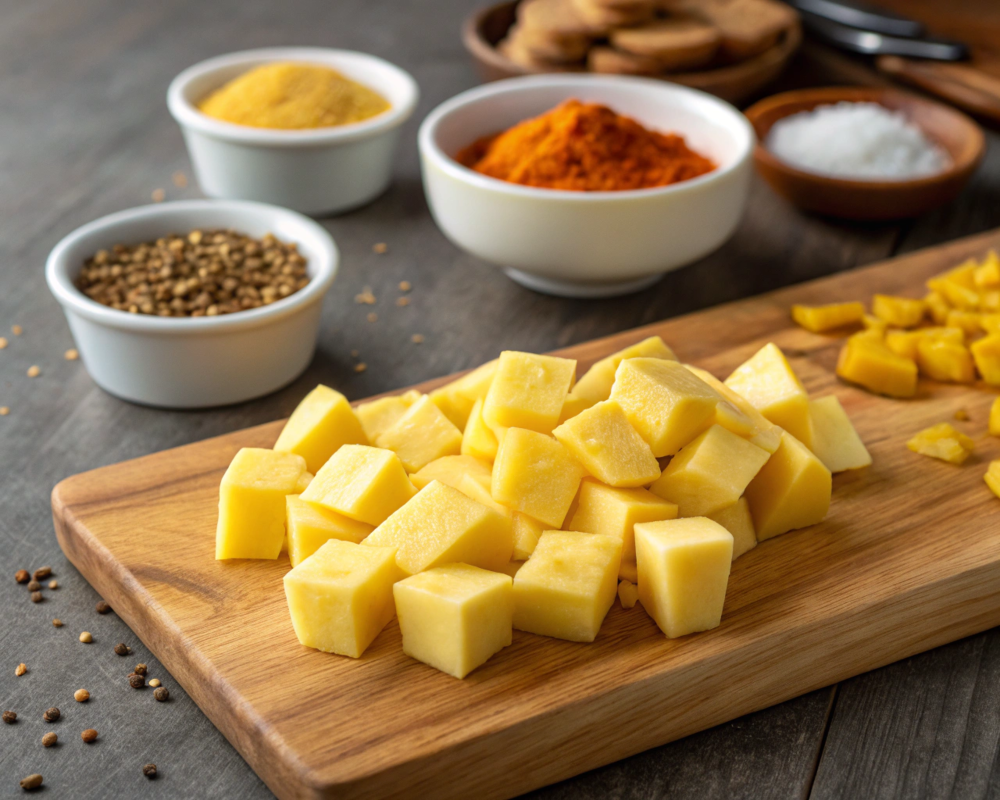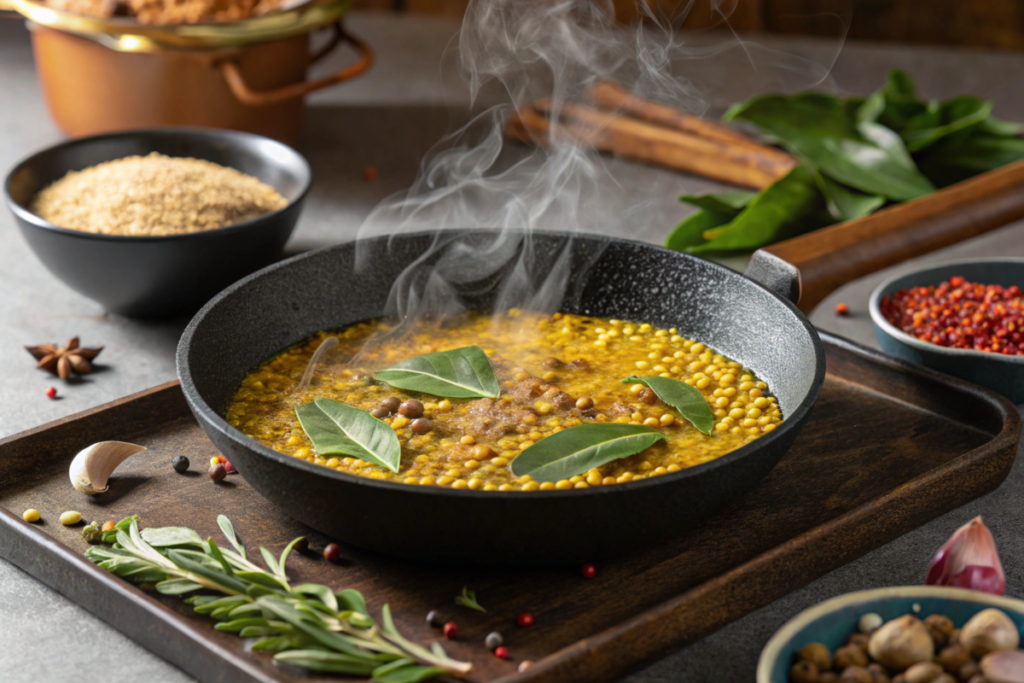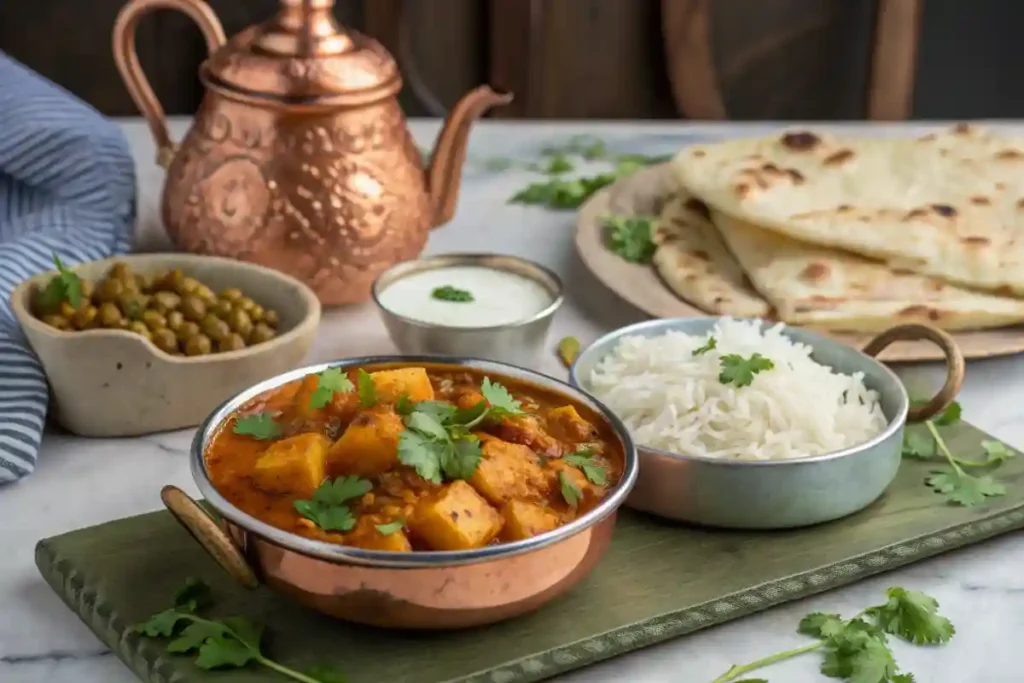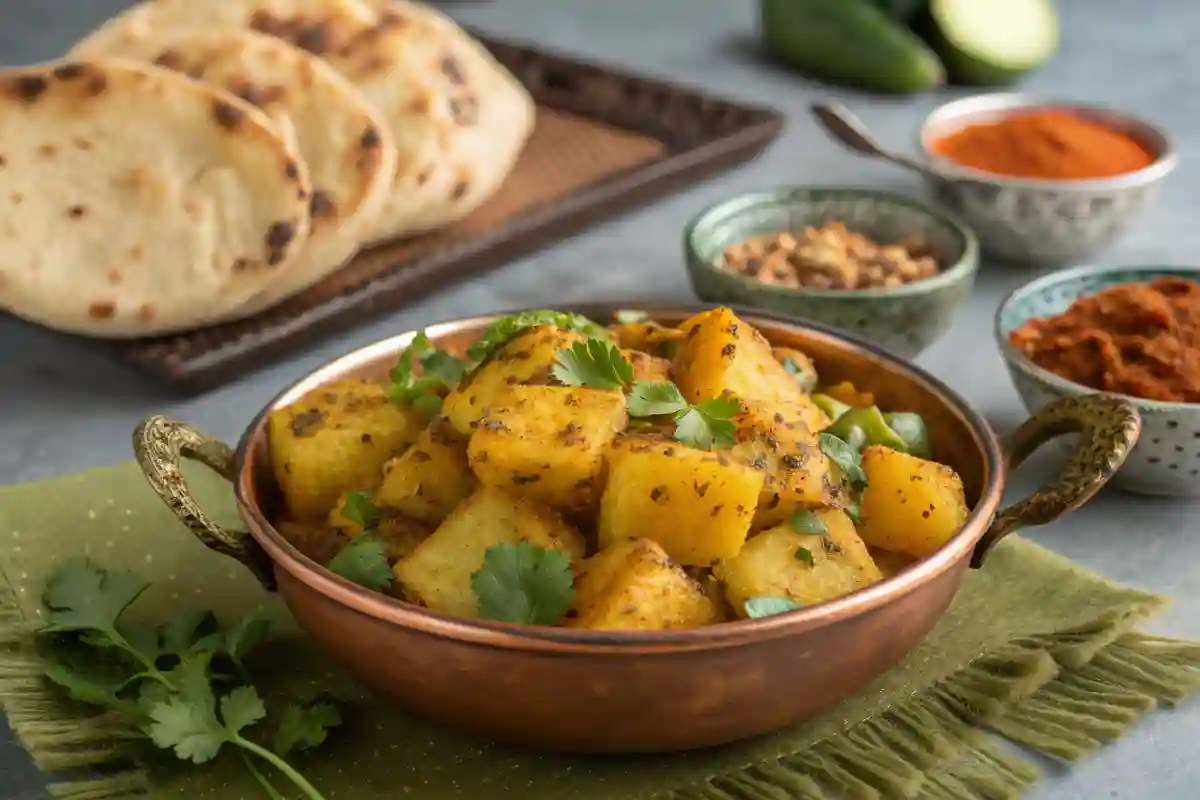Introduction to Bombay Aloo
What is Bombay Aloo Made Of?
Bombay Aloo, a classic Indian dish, consists of tender potatoes seasoned with a medley of spices that deliver bold and earthy flavors. But what exactly goes into making it? At its core, the dish includes potatoes, aromatic spices, and a few simple ingredients that enhance its texture and taste. Perfect as a side dish or a standalone treat, it’s versatile, vegan-friendly, and gluten-free.
Origins and Cultural Significance of Bombay Aloo
Bombay Aloo’s roots trace back to the bustling streets of India, where it’s a staple in households and street food stalls alike. Known for its simplicity, it’s cherished for how it embodies Indian culinary philosophy: turning humble ingredients into something extraordinary. The dish’s adaptability has allowed it to cross borders, becoming a favorite in Indian restaurants worldwide.
Traditional Ingredients in Bombay Aloo
The beauty of Bombay Aloo lies in its simplicity. It’s typically made using golden potatoes, which are cooked with a blend of spices such as turmeric, cumin, and garam masala. Tomatoes, onions, and fresh cilantro often make an appearance, while mustard seeds and garlic add depth. Despite being a simple recipe, each ingredient serves a specific purpose, ensuring every bite is a burst of flavor.
Core Components of Bombay Aloo
Primary Ingredient: Potatoes
Potatoes, the heart of Bombay Aloo, play an indispensable role in its flavor and texture. Their starchy quality allows them to soak up the vibrant spices while maintaining a tender yet firm bite. This humble tuber’s neutral taste acts as a canvas, letting the bold, earthy spices shine. In Indian cooking, potatoes are a versatile staple, loved for their ability to adapt to a variety of spices and preparation methods. In Bombay Aloo, their role is more than just filling; they transform into golden bites of perfection, crisped at the edges and soft inside, adding layers of comfort to every mouthful.

Varieties of Potatoes Used
Choosing the right potatoes is crucial for a successful Bombay Aloo. Varieties like Yukon Gold, Maris Piper, or even red potatoes work wonders because they hold their shape well during cooking. Their creamy texture and natural sweetness complement the spiced flavors beautifully. While waxy potatoes are great for maintaining structure, starchy varieties, like russets, can break down and create a more mashed texture in saucier versions of the dish. Whichever type you choose, uniform size and consistent cooking ensure a perfectly balanced dish.
Preparation Methods for Potatoes
The way potatoes are prepped significantly impacts the final dish. Start by peeling them to ensure the spices adhere better. Chop them into even cubes for uniform cooking. For an authentic Bombay Aloo, parboiling the potatoes before sautéing is a pro tip—it helps them cook faster while achieving a crispy exterior. Some cooks even fry the potatoes briefly before adding them to the spice mix, enhancing their texture. Regardless of the method, the goal is to make sure the potatoes absorb the spices while retaining their integrity.
Essential Spices in Bombay Aloo
Spices are the soul of Bombay Aloo, transforming simple potatoes into a dish bursting with flavor. The magic lies in tempering spices in hot oil, a process that releases their essential oils, unlocking a world of aromas and tastes.

Cumin and Mustard Seeds
Cumin seeds bring a nutty, earthy flavor to the dish, acting as the foundation of Bombay Aloo’s flavor profile. Mustard seeds, on the other hand, add a slight pungency and a subtle crunch. When they sizzle in hot oil, they release an aromatic burst that sets the stage for the other spices. This tempering process not only enhances the dish but also creates a base that binds all the flavors together.
Turmeric and Chili Powder
Turmeric is what gives Bombay Aloo its signature golden hue. But its role doesn’t stop there—it has a slightly bitter, earthy undertone that balances the dish’s richness. Chili powder, meanwhile, adds a kick, making the dish as spicy as you want. Together, these spices create a harmonious blend of warmth and vibrancy, ensuring every bite is as flavorful as it is colorful.
Garam Masala and Other Aromatics
Garam masala, a quintessential Indian spice blend, adds depth and complexity to Bombay Aloo. It’s typically added towards the end of cooking to preserve its aromatic qualities. Additionally, other spices like coriander and fenugreek may be used to enhance the dish further. Coriander adds citrusy brightness, while fenugreek introduces a subtle, sweet-bitter note. These spices round out the flavor profile, ensuring a truly memorable dish.
Additional Ingredients and Variations
Use of Onions and Tomatoes
Onions and tomatoes are the dynamic duo of Indian cooking, and their inclusion in Bombay Aloo is no exception. Onions lend a natural sweetness that balances the heat from the spices, while tomatoes add a tangy brightness that cuts through the richness. Cooked together, they create a flavorful base that enhances the dish’s complexity. Their interplay of sweet and sour makes the final dish even more delightful.
Incorporation of Curry Leaves and Garlic
Curry leaves are small but mighty, packing an intense aroma that elevates Bombay Aloo. Their distinct flavor adds a hint of citrusy bitterness, balancing the dish beautifully. Garlic, a beloved ingredient in Indian cuisine, brings its pungent warmth. When sautéed with spices, it infuses the potatoes with an irresistible depth of flavor. Together, curry leaves and garlic take this dish to the next level.
Regional Variations of Bombay Aloo
Bombay Aloo is as diverse as the regions of India. Each area puts its own spin on the dish, resulting in an array of variations.
Dry vs. Saucy Preparations
In some regions, Bombay Aloo is served dry, with the potatoes coated in a thick spice crust. This version works well as a side dish or snack. In other places, a saucy preparation is preferred, where the potatoes are simmered in a tomato-based gravy. Each version has its charm, catering to different preferences and occasions.
Influence of Local Ingredients
The availability of local ingredients often influences how Bombay Aloo is prepared. Coastal regions might add coconut for a creamy texture, while North Indian versions lean towards richer spices like asafoetida. These local twists not only diversify the dish but also showcase the versatility of Indian cuisine.
Cooking Techniques and Serving Suggestions
Traditional Cooking Methods
Authenticity in preparing Bombay Aloo starts with the age-old techniques passed down through generations. The first crucial step is tempering, where spices like mustard seeds, cumin seeds, and curry leaves are sizzled in hot oil. This not only releases their aromatic oils but also sets the foundation of flavor. The potatoes are then added to the spiced oil, ensuring they are well-coated. Slow cooking is another hallmark of traditional Bombay Aloo preparation, allowing the spices to permeate the potatoes deeply. Often, cooks use an iron skillet or clay pot to enhance the dish’s earthy taste. Stirring occasionally to prevent sticking, the dish is cooked to perfection, achieving a balance of crisp edges and tender interiors.
Modern Adaptations in Preparation
Modern kitchens have embraced quicker and easier ways to prepare Bombay Aloo without compromising its essence. Air fryers are now popular for achieving crispy potatoes with minimal oil. Pressure cookers, on the other hand, can significantly reduce cooking time, especially for parboiling potatoes. Some contemporary recipes even incorporate microwave pre-cooking, which speeds up the process while ensuring the potatoes are soft and ready for seasoning. Additionally, fusion recipes have emerged, introducing global spices and ingredients while retaining the dish’s core identity.
Serving Bombay Aloo

Bombay Aloo is a crowd-pleaser that adapts seamlessly to various meal settings. It can be served as a side dish alongside naan or roti, or as a hearty filling for wraps and sandwiches. The dish also shines as a main course when paired with a bowl of fragrant basmati rice. For a lighter option, Bombay Aloo can be enjoyed as a snack, garnished with fresh cilantro and a squeeze of lemon juice.
Accompaniments and Pairings
Pairing Bombay Aloo with the right accompaniments elevates the overall dining experience. Its bold flavors are complemented by the simplicity of plain naan or the buttery richness of parathas. For a full meal, serving it with steamed rice or lightly spiced jeera rice (cumin rice) adds balance. A cooling side like raita—a yogurt-based dish with cucumbers or mint—helps temper the heat, creating a harmonious plate.
Presentation Styles
The way you present Bombay Aloo can make it even more enticing. For family meals, a rustic serving in an iron skillet or clay pot adds charm. Individual portions plated with a dollop of yogurt and a sprig of fresh coriander are perfect for formal dinners. For a festive touch, serve it in a banana leaf or a traditional Indian thali. These thoughtful presentation ideas not only enhance the visual appeal but also reflect the dish’s cultural richness.
Nutritional Aspects and Dietary Considerations
Nutritional Profile of Bombay Aloo
Bombay Aloo is more than just delicious; it’s also packed with nutritional benefits. Potatoes are an excellent source of carbohydrates, providing energy for the day. The spices used, such as turmeric and cumin, boast anti-inflammatory and antioxidant properties. While the dish can be calorie-dense due to the oil, it also offers a balance of fats and essential nutrients. With moderate portions, Bombay Aloo can be a wholesome part of a well-rounded diet.
Adaptations for Dietary Preferences
One of the best features of Bombay Aloo is its flexibility in meeting dietary needs. For those watching their calorie intake, the recipe can be modified by reducing the oil and substituting full-fat ingredients with lighter options. If you’re catering to a salt-restricted diet, the dish can still shine by leaning into its natural spices. Additionally, it pairs well with high-protein sides, such as lentils, for a more balanced meal.
Vegan and Gluten-Free Options
Naturally, Bombay Aloo is both vegan and gluten-free, making it an inclusive dish for a variety of dietary preferences. For vegans, traditional ghee can be replaced with plant-based oils like coconut or sunflower oil. Ensuring the spice mix is free of gluten-containing additives keeps the dish safe for those with gluten sensitivities. These small tweaks preserve the dish’s authentic taste while making it suitable for everyone.
Healthier Cooking Alternatives
For those looking to make Bombay Aloo healthier, a few easy swaps can make all the difference. Using an air fryer instead of deep frying reduces oil usage significantly. Adding more vegetables, like peas or spinach, increases fiber content and nutrients. Finally, switching to olive oil or avocado oil can provide healthier fats without sacrificing flavor. These alternatives keep the dish nutritious while retaining its traditional essence.
Frequently Asked Questions
FAQs about Bombay Aloo
Bombay Aloo is a dish that intrigues many with its simplicity and bold flavors. Below are some common questions and answers that shed light on its origins, variations, and practical tips.
What is the origin of Bombay Aloo?
Bombay Aloo has its roots in Indian cuisine, particularly in the bustling city of Mumbai, formerly known as Bombay. It’s a reflection of India’s culinary philosophy, where basic ingredients like potatoes and spices are transformed into flavorful dishes. Over time, this humble dish has become a favorite globally, celebrated for its rich taste and versatility.
Can I use sweet potatoes instead of regular potatoes?
Absolutely! Sweet potatoes make a fantastic substitute for regular potatoes in Bombay Aloo. They add a subtle sweetness that pairs beautifully with the spices. To ensure the best results, reduce the cooking time slightly, as sweet potatoes tend to cook faster. This variation also makes the dish higher in fiber and nutrients.
How spicy is Bombay Aloo typically?
The spiciness of Bombay Aloo varies depending on the amount of chili powder or fresh chilies used. Traditionally, it has a moderate heat level, balanced by the earthy spices. For a milder version, reduce the chili powder or substitute it with paprika for a gentle kick without overwhelming heat.
What dishes pair well with Bombay Aloo?
Bombay Aloo is incredibly versatile and pairs wonderfully with Indian bread like naan or paratha. It’s also an excellent accompaniment to rice dishes, such as jeera rice or plain steamed basmati. For a complete meal, serve it alongside lentil-based dishes like dal tadka or a refreshing cucumber raita.
How do I store and reheat leftovers?
To store leftovers, place them in an airtight container and refrigerate for up to three days. When reheating, add a splash of water or a drizzle of oil to prevent the dish from drying out. Use a stovetop or microwave to warm it, stirring occasionally to ensure even heating.
Is Bombay Aloo suitable for a vegan diet?
Yes, it is naturally vegan as it’s made with plant-based ingredients like potatoes, spices, and cooking oil. To ensure it stays vegan, avoid using ghee and stick to vegetable oils. It’s also gluten-free, making it an inclusive dish for various dietary preferences.

